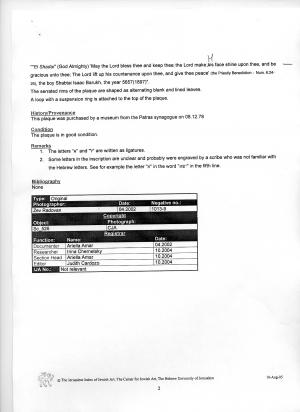Obj. ID: 5650
Sacred and Ritual Objects Dedicatory plaque, Patras, 1897

The dedicatory plaque is shaped as a reversed heart with serrated rims. It encloses the Priestly Benediction accompanied by a dedication and framed by a strip, which follows the plaque's form and is decorated with a linear pattern. The name of the Lord "El Shadai" (God Almighty) is written in larger square, outlined letters, while the following inscription is inscribed in semi cursive, linear letters. The inscription is arranged in eight lines and reads:
"אל/ שדי/ יברכך ה' ויש'' (וישמרך)/ יאר ה' פניו אליך/ ויחנך ישא ה' פניו/ אליך וישם לך שלום (ברכת כהנים - במדבר ו:כד-כו)/ הילד שב''תי יצחק/ ברוך ש' (שנת) התרנז."
"El Shadai (God Almighty), 'May the Lord bless thee and keep thee; the Lord make His face shine upon thee, and be gracious unto thee; The Lord lift up his countenance upon thee, and give thee peace' (the Priestly Benediction - Num. 6:24-26), the boy Shabtai Isaac Baruch, the year 5657(1897)."
The serrated rims of the plaque are shaped as alternating blank and lined leaves. A loop with a suspension ring is attached to the top of the plaque.
- The letters "א" and "ל" are written as ligatures.
- Some letters in the inscription are unclear and probably were engraved by a scribe who was not familiar with the Hebrew letters. See for example the letter "א" in the word "ישא" in the fifth line.
sub-set tree:
objects known as shadai'ot (shadai'a in singular). The custom of
donating these plaques is common among the Greek Romaniot
communities. The name shadai'a is derived from God’s name,
"אל שדי" (El Shadai = God Almighty) which usually heads the
dedicatory inscription. The plaque is also called a "takhshit," namely an ornament, which adorns the Torah, a term often inscribed on the plaques. This shadai'a is part of a larger group of plaques, documented in several collections around the world, which together forms the most comprehensive collection of shadai'ot.
The dedication of silver plaques as sacred objects is unique to the Greek Romaniot communities. Some inscriptions do reveal that occasionally they were donated with other ritual objects, such as a Torah scroll, a parokhet, or a mappah. Yet, unlike the common custom in other communities, they were not attached to specific ritual objects at the time of the donation. When a large number of shadai'ot plaques were assembled in a synagogue they were sewn on to a parokhet in a reversed "Π" shape. Some were also attached to Torah case wrappers or belts, which were probably hung along the walls of the synagogue on different occasions.
Although the events mentioned in the dedicatory inscriptions occurred at different times, the plaques were consistently donated to the synagogue on special days in the Jewish Year. The three pilgrimage festivals (Passover, Shavu'ot, Sukkot) are common, as well as Rosh Ha-Shanah, Yom Kippur, Rosh Hodesh (the New Moon) and Sabbaths. Rarely does the date of the donation mentioned on the plaque indicate another day of the week.
The custom was practiced among the Romaniot communities of Arta, Ioannina, Previzia, and is still practiced in Trikala and Larissa. No differences were noticeable between the two congregations in Ioannina concerning shape, dedicatory formulas or names of donors. The only distinction between the Old and New Holy Congregations is the name of the synagogue (when it appears). Most contemporary shadai'ot from Trikala and Larissa differ from the others and are shaped as Stars of David enclosed within circles. Few of them maintain the early linguistic dedicatory formulas.
The shadai'ot are important historical documents, which reflect both the artistic and the cultural heritage of the Romaniot communities in Greece. Their importance goes beyond the art of sacred objects; this unique custom offers a fascinating window to the rich Greek Jewish culture in the past four hundred years.
The dedicatory inscription beginning with the name of the Lord El Shadai (God Almighty) is accompanied by part of the Priestly Benediction, and is framed by a strip following the form of the plaque.
Amar, Ariella, and Irina Chernetsky. Shadai'ot: The Collection of the Jewish Museum of Greece. Jerusalem: The Center for Jewish Art, The Hebrew University of Jerusalem, 2006. Internal publication.






